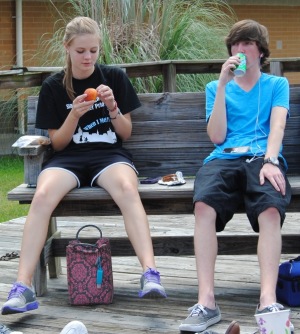Healthier cafeteria food mandate means certain foods had to go
Sophomores Connor Donahue ( far left) and Jake Odom (left), eat their filling sack-lunches during B lunch. Nick Palmer (right) eats a school lunch consisting of garlic French bread pizza, some carrots, and a bag of Cheetos.
December 3, 2014
Back in early August, senior Kale Walker was headed to the lunch room with his buddies. He was looking forward to the same mid-day meal fare he had been enjoying for years. But he was disappointed to see that the a la carte line was missing.
“That was completely unexpected,” Walker said. He and many other students noticed changes in the food served in the cafeteria, vending machines, and school store. Why? All schools that participate in the National School Lunch Program must adhere to a federal government program that focuses on reducing childhood obesity, which, in several reports , has doubled in children and quadrupled in adolescents in the last 30 years. Nutritionists believe that reducing the fats, salt, and sugar in the foods students eat at school is a good place to start.
To raise awareness about the national obesity epidemic, First lady Michelle Obama launched her campaign Let’s Move to “Raise A Healthier Generation of Kids” in February 2010. Her campaign has five parts, one of which is “to provide healthy food in schools.” President Barack Obama signed the Healthy Hunger-Free Kids Act of 2010, which reauthorized the funding for child nutrition in schools with certain programs like the school lunch program. The healthy kids act requires that the U.S. Department of Agriculture provide healthier foods in schools. Another federal law, Smart Snacks in Schools, passed by Congress in July 2014, ensures students are receiving healthier food items. Smart Snacks in Schools led to the removal of the a la carte line that Walker loved so much because none of the foods met the new guidelines.
“I could always rely on chicken tenders, fries, or chips whenever I didn’t like what was offered in the regular menu,” Walker said. “At least before, there was a choice, but now that choice is gone.”

So why were Walker’s go-to foods removed? According to cafeteria manager Maureen Hankey, “[The U.S. Department of Agriculture] is big on reducing the sodium level this year, and those foods contained a substantial amount of sodium.”
As a result, other foods like mozzarella sticks, pizza slices, chicken sandwiches, and hot dogs were removed too. Drinks like lemonade and sweet tea didn’t make the cut either.
The ripple-like effect from the law caused the removal of vending machines in the gym lobby, the 800 hall and two soda machines in the cafeteria. Healthier items, like low-fat chips such as Baked Lays and reduced fat Doritos, replaced the salty chips and sugary candy in the remaining machines in the 700 and 600 halls, and in the cafeteria. Sophomores Kali Owens and Scott Sundloff said they definitely see fewer people visiting the vending machines throughout the school day.
In previous years, teacher Cheryl Clower, chapter adviser of Family, Career, and Community Leaders of America, used to sell snacks during the 10-minute break with her FCCLA students, but the new guidelines prohibit the sale of many snacks they sold. The result is that “lots of schools are losing money and are in the red,” Clower said. “The students who are not finding the healthier foods appetizing aren’t buying anything.” Clower worries that students who used to depend on the vending machines and snacks sold during the 10-minute break after second period will go hungry during the day. The school no longer has a 10-minute break.
Another effect is that the school store, located at the front of the cafeteria, faced menu reductions as well. It is still open during the three lunch periods, but in years past it sold slushies and packaged snacks like Goldfish and SunChips. “Now, we sell low-fat ice cream, chocolate chip cookies, and water,” said Jeff Klein, who teaches the Entrepreneurship course and operates the school store.
Students continue to buy school lunches but the majority of them have noticed a difference in their daily meal The regular lunch menu looks the same as in past years, but students’ taste buds detected changes. The vegetables and mashed potatoes in particular are a bit blander, said sophomore Isabella Hubbard, who suggested that “some type of seasoning should be offered.”
Another student, sophomore Alexandria Thomas, always purchases her lunch from the regular lines but feels that the menu doesn’t offer as many choices as she enjoyed last year and repeats too frequently. Thomas’ intuitions are correct because, according to Hankey, “there is a three week rotation cycle along with daily and weekly guidelines [that control the amount of sugar, salt, and fat consumed each week and month].” One key food present in almost every meal that had to undergo changes was the bread. “ Now it is baked fresh daily in the mornings,” Hankey said, “It’s 51 percent whole wheat.” This seems to be one of the changes that went unnoticed.
Students claim that portion sizes are smaller too. Sophomore Kate Chasey said that her friends who buy school lunches are still hungry after they eat and ask others for food. Walker agreed. “The food lacks enough substance to fill me,” he said.
Kokeeta Wilder, school nutrition director for Fayette County public schools, counters that. “Our portion sizes didn’t change at all,” she said. “We still offer the same portion sizes as before. In many cases, we offer a larger portion size than what USDA requires.”
However, Walker found this hard to believe and he wonders why the canteen can’t just make its own meals. According to the Local School Wellness Policy from the USDA, as long as the school is participating in the school lunch program, it must abide by the Smart Snacks in Schools’ guidelines. If the school isn’t a part of the school lunch program, theoretically the school could buy its own produce and cook its own lunches but “that would be costly,” Clower said. Hankey said that the cafeteria staff has to prepare about 700 daily lunches for students at both Rising Starr and Starr’s Mill. The schools share a common kitchen. It would be impossible to cook that many “fresh” lunches each day, according to Hankey.
Despite the benefits of the healthier foods served at lunch, some students still gripe about the food.
Flash forward three months. It’s late November and Walker continues to purchase cafeteria food. One day he bought nachos. The next day it was a meatball marinara sub. “I don’t like not having the extra [a la carte] option, but I’m getting used to it,” Walker said. “It would still be nice to have more choices though.”





